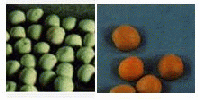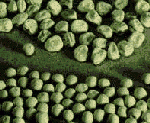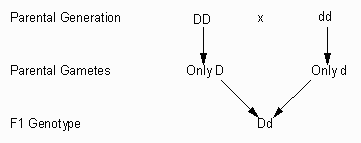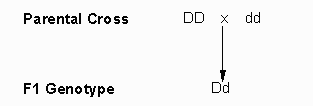Mendel's Genetics
For thousands of years farmers and herders have been selectively breeding their plants and animals to produce more useful hybrids . It was somewhat of a hit or miss process since the actual mechanisms governing inheritance were unknown. Knowledge of these genetic mechanisms finally came as a result of careful laboratory breeding experiments carried out over the last century and a half.
By the 1890's, the invention of better microscopes allowed biologists to discover the basic facts of cell division and sexual reproduction. The focus of genetics research then shifted to understanding what really happens in the transmission of hereditary traits from parents to children. A number of hypotheses were suggested to explain heredity, but Gregor Mendel , a little known Central European monk, was the only one who got it more or less right. His ideas had been published in 1866 but largely went unrecognized until 1900, which was long after his death. His early adult life was spent in relative obscurity doing basic genetics research and teaching high school mathematics, physics, and Greek in Brno (now in the Czech Republic). In his later years, he became the abbot of his monastery and put aside his scientific work.
Through the selective cross-breeding of common pea plants (Pisum sativum) over many generations, Mendel discovered that certain traits show up in offspring without any blending of parent characteristics. For instance, the pea flowers are either purple or white--intermediate colors do not appear in the offspring of cross-pollinated pea plants. Mendel observed seven traits that are easily recognized and apparently only occur in one of two forms:
| 1. | flower color is purple or white | 5. | seed color is yellow or green | ||||||||||||||||||||||||||||||||||||||||||||||||||||||||||||||||||||||||||||||||||||||||||||||||||||||
|---|---|---|---|---|---|---|---|---|---|---|---|---|---|---|---|---|---|---|---|---|---|---|---|---|---|---|---|---|---|---|---|---|---|---|---|---|---|---|---|---|---|---|---|---|---|---|---|---|---|---|---|---|---|---|---|---|---|---|---|---|---|---|---|---|---|---|---|---|---|---|---|---|---|---|---|---|---|---|---|---|---|---|---|---|---|---|---|---|---|---|---|---|---|---|---|---|---|---|---|---|---|---|---|---|---|
| 2. | flower position is axil or terminal | 6. | pod shape is inflated or constricted | ||||||||||||||||||||||||||||||||||||||||||||||||||||||||||||||||||||||||||||||||||||||||||||||||||||||
| 3. | stem length is long or short | 7. | pod color is yellow or green | ||||||||||||||||||||||||||||||||||||||||||||||||||||||||||||||||||||||||||||||||||||||||||||||||||||||
| 4. | seed shape is round or wrinkledMendel's First Law of Genetics (Law of Segregation)Genetic analysis predates Gregor Mendel, but Mendel's laws form the theoretical basis of our understanding of the genetics of inheritance.Mendel made two innovations to the science of genetics:
Results from Mendel's Experiments
Phenotype - literally means "the form that is shown"; it is the outward, physical appearance of a particular trait Mendel's pea plants exhibited the following phenotypes:
 Seed Shape: Wrinkled and Round seeds.  What is seen in the F1 generation? We always see only one of the two parental phenotypes in this generation. But the F1 possesses the information needed to produce both parental phenotypes in the following generation. The F2 generation always produced a 3:1 ratio where the dominant trait is present three times as often as the recessive trait. Mendel coined two terms to describe the relationship of the two phenotypes based on the F1 and F2 phenotypes. Dominant - the allele that expresses itself at the expense of an alternate allele; the phenotype that is expressed in the F1 generation from the cross of two pure lines Recessive - an allele whose expression is suppressed in the presence of a dominant allele; the phenotype that disappears in the F1 generation from the cross of two pure lines and reappears in the F2 generation Mendel's Conclusions
Mendelian Genetics Definitions
 The F2 generation was created by selfing the F1 plants. This can be depicted graphically in a Punnett square. From these results Mendel coined several other terms and formulated his first law. First the Punnett Square is shown.
Genotypic ratio of F2: 1 DD : 2 Dd : 1 dd (or 3 D_ : 1 dd) Phenotypic ratio of F2: 3 tall : 1 dwarf Mendel's First Law - the law of segregation; during gamete formation each member of the allelic pair separates from the other member to form the genetic constitution of the gamete Confirmation of Mendel's First Law Hypothesis With these observations, Mendel could form a hypothesis about segregation. To test this hypothesis, Mendel selfed the F2 plants. If his law was correct he could predict what the results would be. And indeed, the results occurred has he expected.  From these results we can now confirm the genotype of the F2 individuals.
This data was also available from the Punnett Square using the gametes from the F1 individual. So although the phenotypic ratio is 3:1 the genotypic ratio is 1:2:1 Mendel performed one other cross to confirm the hypothesis of segregation --- the backcross. Remember, the first cross is between two pure line parents to produce an F1 heterozygote.  At this point instead of selfing the F1, Mendel crossed it to a pure line, homozygote dwarf plant. Backcross: Dd x dd
BC1 Genotypes: 1 Dd : 1 dd Backcross - the cross of an F1 hybrid to one of the homozygous parents; for pea plant height the cross would be Dd x DD or Dd x dd; most often, though a backcross is a cross to a fully recessive parent Testcross - the cross of any individual to a homozygous recessive parent; used to determine if the individual is homozygous dominant or heterozygous So far, all the discussion has concentrated on monohybrid crosses. Monohybrid cross - a cross between parents that differ at a single gene pair (usually AA x aa) Monohybrid - the offspring of two parents that are homozygous for alternate alleles of a gene pair Remember --- a monohybrid cross is not the cross of two monohybrids. Monohybrids are good for describing the relationship between alleles. When an allele is homozygous it will show its phenotype. It is the phenotype of the heterozygote which permits us to determine the relationship of the alleles. Dominance - the ability of one allele to express its phenotype at the expense of an alternate allele; the major form of interaction between alleles; generally the dominant allele will make a gene product that the recessive can not; therefore the dominant allele will express itself whenever it is present. Mendel's First Law of Genetics (Law of Segregation)Genetic analysis predates Gregor Mendel, but Mendel's laws form the theoretical basis of our understanding of the genetics of inheritance.Mendel made two innovations to the science of genetics:
Results from Mendel's Experiments
Phenotype - literally means "the form that is shown"; it is the outward, physical appearance of a particular trait Mendel's pea plants exhibited the following phenotypes:
 Seed Shape: Wrinkled and Round seeds.  What is seen in the F1 generation? We always see only one of the two parental phenotypes in this generation. But the F1 possesses the information needed to produce both parental phenotypes in the following generation. The F2 generation always produced a 3:1 ratio where the dominant trait is present three times as often as the recessive trait. Mendel coined two terms to describe the relationship of the two phenotypes based on the F1 and F2 phenotypes. Dominant - the allele that expresses itself at the expense of an alternate allele; the phenotype that is expressed in the F1 generation from the cross of two pure lines Recessive - an allele whose expression is suppressed in the presence of a dominant allele; the phenotype that disappears in the F1 generation from the cross of two pure lines and reappears in the F2 generation Mendel's Conclusions
Mendelian Genetics Definitions
 The F2 generation was created by selfing the F1 plants. This can be depicted graphically in a Punnett square. From these results Mendel coined several other terms and formulated his first law. First the Punnett Square is shown.
Genotypic ratio of F2: 1 DD : 2 Dd : 1 dd (or 3 D_ : 1 dd) Phenotypic ratio of F2: 3 tall : 1 dwarf Mendel's First Law - the law of segregation; during gamete formation each member of the allelic pair separates from the other member to form the genetic constitution of the gamete Confirmation of Mendel's First Law Hypothesis With these observations, Mendel could form a hypothesis about segregation. To test this hypothesis, Mendel selfed the F2 plants. If his law was correct he could predict what the results would be. And indeed, the results occurred has he expected.  From these results we can now confirm the genotype of the F2 individuals.
This data was also available from the Punnett Square using the gametes from the F1 individual. So although the phenotypic ratio is 3:1 the genotypic ratio is 1:2:1 Mendel performed one other cross to confirm the hypothesis of segregation --- the backcross. Remember, the first cross is between two pure line parents to produce an F1 heterozygote.  At this point instead of selfing the F1, Mendel crossed it to a pure line, homozygote dwarf plant. Backcross: Dd x dd
BC1 Genotypes: 1 Dd : 1 dd Backcross - the cross of an F1 hybrid to one of the homozygous parents; for pea plant height the cross would be Dd x DD or Dd x dd; most often, though a backcross is a cross to a fully recessive parent Testcross - the cross of any individual to a homozygous recessive parent; used to determine if the individual is homozygous dominant or heterozygous So far, all the discussion has concentrated on monohybrid crosses. Monohybrid cross - a cross between parents that differ at a single gene pair (usually AA x aa) Monohybrid - the offspring of two parents that are homozygous for alternate alleles of a gene pair Remember --- a monohybrid cross is not the cross of two monohybrids. Monohybrids are good for describing the relationship between alleles. When an allele is homozygous it will show its phenotype. It is the phenotype of the heterozygote which permits us to determine the relationship of the alleles. Dominance - the ability of one allele to express its phenotype at the expense of an alternate allele; the major form of interaction between alleles; generally the dominant allele will make a gene product that the recessive can not; therefore the dominant allele will express itself whenever it is present. Genetics is the study of heredity and variation in organisms. We begin with a study of the monohybrid cross, invented by Mendel. In a monohybrid cross, organisms differing in only one trait are crossed. Our objective is to understand the principles that govern inheritance in plants and animals, including humans, by solving problems related to the monohybrid cross. shailesh kr shukla 167shailesh.bot@gmail.com |
No comments:
Post a Comment